Eight Limbs of RajaYoga (Patanjali Ashtanga Yoga)
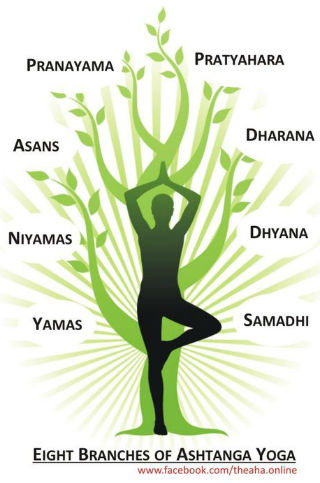
There are eight limbs of Yoga which together help us attain the highest realization of Samadhi. Patanjali Yoga Sutras 2:29 lists them as follows:
"Yama niyamasana pranayama pratyahara dharanadhyanasamadhayoshtavangani" - Patanjali Yoga Sutras: Sadhana Pada: Verse 29
"Yama," "niyama," "asana," "pranayam," "pratyahar," "dharana," "dhyan" and "samadhi" -- these are the eight limbs of yoga. - Patanjali Yoga Sutras: Sadhana Pada: Verse 29
Yama (Restraints)
Yamas are 5, they are:
Tatrahimsasatyasteya brahmacharyaparigraha yamah - Patanjali Yoga Sutras 2:30
- Ahimsa (non-Violence): Non-violence in not just actions but thoughts as well, Non-violence leads to Non-malice, thus purity
- Satya (Truthfulness): Non-lying or Acting in accordance to the highest good of everyone, Truthful living leads to fruitful Yogic practices.
- Asteya (Non-stealing): When non-stealing of others' property is established, there is discipline and hardwork and thus riches righteously earned.
- Brahmacārya (Disciplined Living, chastity): When Brahmacharya is established there is Valour, there is vigour in personality and depth in studies. Leads to perfection.
- Aparigraha (Non-possessiveness): When non acceptance of unnecessary things is practiced, detachment is easier, it leads to remembrance of the past and knowledge of the future.
Niyamas (Observances)
There are 5 Niyamas (observances), they are:
Shaucha santosha tapah svadhyayayeshvara pranidhanani niyamah - Patanjali Yoga Sutras 2:32
- Shaucha (Cleanliness): With understanding of impurities & purities of body & mind, disinterest in worldly objects comes, with that detachment comes. With purity comes Sattva & calmness, one-pointed ness, control over senses.
- Santosha (Contentment): With content comes happiness, with content comes patience to sit for longer time at one place, with content comes mental equilibrium necessary to reach depths of Yoga.
- Tapah (Perseverance): With austerity comes the mental one-pointed ness, impurities are removed from the body & the senses, with the continued practice of staying in one's Ajna chakra, one becomes firm on the path of Yoga, this leads to realization of spiritual powers like Anima, Mahima and so on.
- Svadhyaya (Self-study): Study of the self, or study of the scriptures by the self. Keeps one refreshed & rooted in the scriptural knowledge.
- Ishvara Pranidhana (Contemplation of Ishvara, God): Contemplation on Ishvara (Lord), by keeping one's mind in the Kutashta Chaitanya for long periods leads to a gradual realization of Self.
Asana (Posture):
The purpose of Asanas (Hatha Yoga) is to have steadiness, to have control over body and mind so that body and mind do not become obstacles when practicing Dharana, Dhyana, Samadhi.
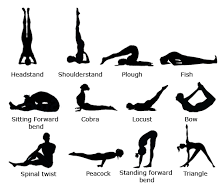
Body produces neural signals when a part of body is under stress, when body is not firm, balance is not easy, Yogasanas which are also collectively called Hatha Yoga make one's body a well tuned instrument, some poetically say Yogasanas build a fine temple of body for the divine to occupy it.
There are 84 classically ("Goraksha Samhita", "Hatha Yoga Pradipika") explained Yogic Postures, Some of the popular Yogasanas (Yoga Postures) are:
- Padmasana: Lotus Posture
- Vajrasana: Thunderbolt Pose
- Dhanurasana: Bow Pose
- Halasana: Plough Pose
- Mayurasana: Peacock Pose
- Bhujangasana: cobra Pose
- Sarvangasana: Shoulder stand pose
- Matsyasana: Fish pose
- Baddha Koṇāsana: Bound angle
- Shavasana: Corpse Pose
Yogasana is a combination of rhythmic breathing & a posture, these postures were classically copied from the postures of animals in nature, thus it is said there are 840,000 postures over all each corresponding to a species.
Pranayama (Control of Prana)
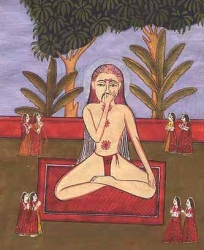
Prana is the flow of life-energy, an energy related to the combined astral & Physical body. With our every action, thought, feeling there is movement of energy inside. The purpose is to steady the Prana, so that there is no sudden and uneven movement which disturbs the mind.
Pranayamas are often practiced with Mudras, by using some fingers and folding some to make better use of internal energy movement towards stilling the body-mind.
Some of the popularly used Pranayamas are:
- Anuloma prāṇāyāma (alternate nostril breath)
- Bhastrika prāṇāyāma ("bellows breath")
- Kapalabhati prāṇāyāma ("skull shining breath")
- Kumbhaka prāṇāyāma ("Breath retention")
- Lom Anulom Vilom prāṇāyāma.
- Udgeeth prāṇāyāma ("Chanting prāṇāyāma")
Pratyahara (withdrawal of the senses)
Withdrawal of the energy from the senses for the sake of directing it inward. This is the practice of minimalising the effect of external world on the practice of Yoga.
A thorough practice of Pratyaharas prepares one for higher stages. After the withdrawal of mind from senses, internal focus increases, one starts hearing Sounds of AUM or seeing the light at the Ajna chakra
Dharana (concentration)
Focus, concentration, One-pointed ness though not the highest objective is certainly a powerful tool in eliminating the unnecessary mental habits, once one achieves the ability to focus mind intensely, thoughts do not come and disturb one unnecessarily.
Dharana is practiced by focusing on objects, light or sounds initially, later as one grows spiritually one hears variations of AUM, concentrating on which is far easier and more fruitful, so is the case with the phenomenon of seeing astral light.
Dhyana (Meditation)
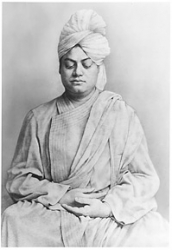
Dhayana is the unbroken steadiness of the mind, mind is still, one-pointed and stable without movement, when that state is achieved it is called dhyana.
A new yogi finds his mind swayed every now and then, but in between he too experiences glimpses of stillness. Over time as one becomes steady in practice, internalization leads to stillness, even over extended periods.
Stillness thus attained leads to extreme concentration, detachment, unbiased judgement, calmness in general activities, control over fear.
Samadhi (Spiritual Absorption)
Sama=even/equal; Dhi= consciousness/ intelligence.
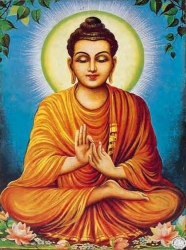
When mind is so still that he escapes the mental limitations imposed on one by the nature, he or she is said to be one with consciousness, the pure being, the true Self.
Realizing the oneness with consciousness by subduing the mind is said to be the highest realization there is, the finality of all quest, the purpose of Yoga & all other spiritual practices.